Money and Capital Markets Report: Royal Commission Analysis
VerifiedAdded on 2023/01/19
|14
|2955
|36
Report
AI Summary
This report provides a comprehensive analysis of the money and capital markets, focusing on the findings and recommendations of the Royal Commission into Misconduct in the Banking, Superannuation, and Financial Services Industry. It begins with an introduction to the Australian financial landscape, including the dominance of the big four banks and the reasons behind establishing the Royal Commission. The report then delves into specific scandals within the banking and financial services sector, such as the Storm Financial scandal and the fee-for-no-service scandal, and the impact of the Productivity Commission's recommendations on competition. Furthermore, it examines the Royal Commission's role in regulating loans, the implications for executive compensation, and the roles of regulatory bodies like APRA and ASIC. Finally, the report critically evaluates key recommendations, including the 'Best interests duty' and the role of mortgage brokers, assessing their necessity and potential impact on the financial services sector. The report concludes with a summary of key findings and recommendations for the future of the financial market.

Money and capital market
Name:
Course:
Word count: 2004 words
Name:
Course:
Word count: 2004 words
Paraphrase This Document
Need a fresh take? Get an instant paraphrase of this document with our AI Paraphraser
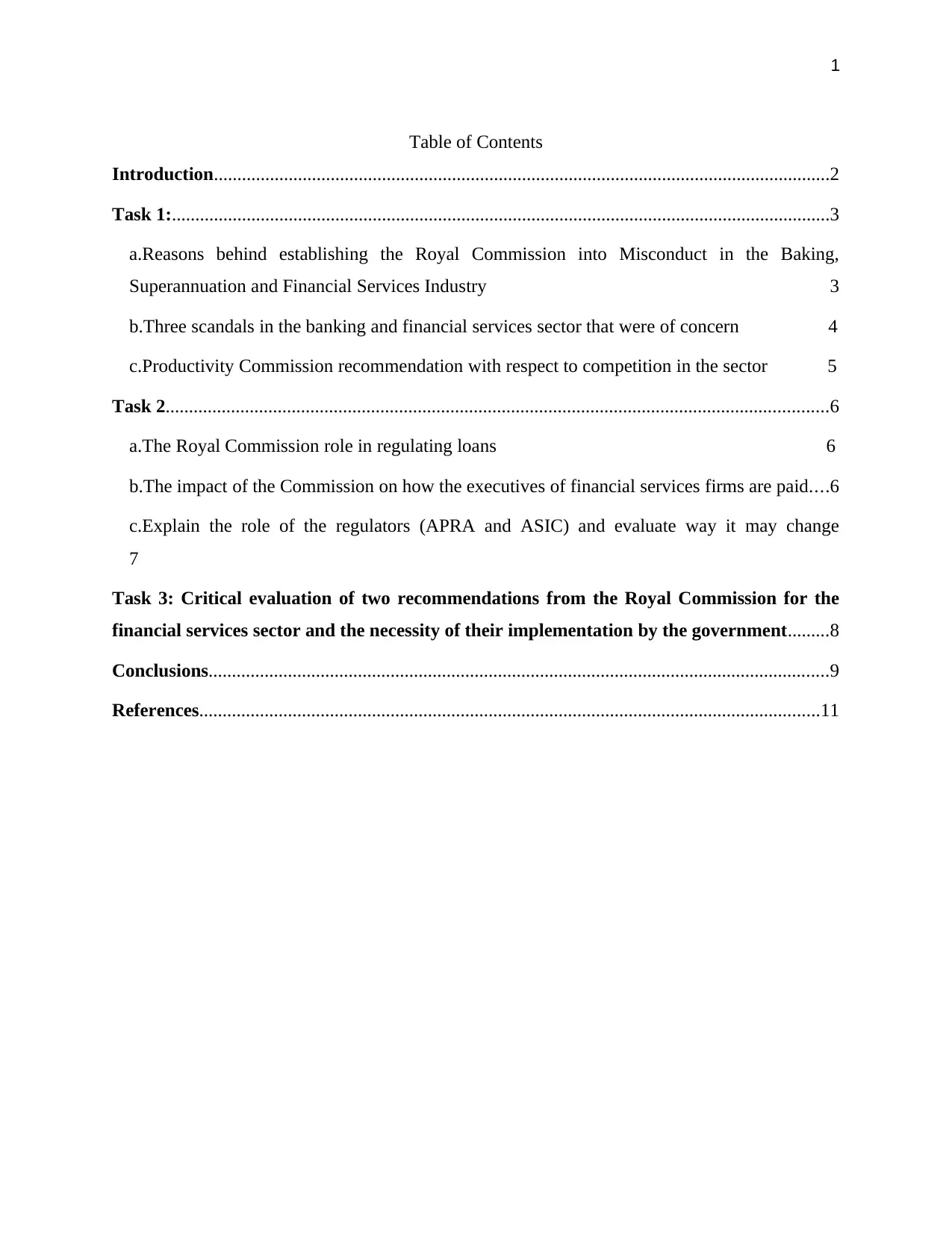
1
Table of Contents
Introduction....................................................................................................................................2
Task 1:.............................................................................................................................................3
a.Reasons behind establishing the Royal Commission into Misconduct in the Baking,
Superannuation and Financial Services Industry 3
b.Three scandals in the banking and financial services sector that were of concern 4
c.Productivity Commission recommendation with respect to competition in the sector 5
Task 2..............................................................................................................................................6
a.The Royal Commission role in regulating loans 6
b.The impact of the Commission on how the executives of financial services firms are paid....6
c.Explain the role of the regulators (APRA and ASIC) and evaluate way it may change
7
Task 3: Critical evaluation of two recommendations from the Royal Commission for the
financial services sector and the necessity of their implementation by the government.........8
Conclusions.....................................................................................................................................9
References.....................................................................................................................................11
Table of Contents
Introduction....................................................................................................................................2
Task 1:.............................................................................................................................................3
a.Reasons behind establishing the Royal Commission into Misconduct in the Baking,
Superannuation and Financial Services Industry 3
b.Three scandals in the banking and financial services sector that were of concern 4
c.Productivity Commission recommendation with respect to competition in the sector 5
Task 2..............................................................................................................................................6
a.The Royal Commission role in regulating loans 6
b.The impact of the Commission on how the executives of financial services firms are paid....6
c.Explain the role of the regulators (APRA and ASIC) and evaluate way it may change
7
Task 3: Critical evaluation of two recommendations from the Royal Commission for the
financial services sector and the necessity of their implementation by the government.........8
Conclusions.....................................................................................................................................9
References.....................................................................................................................................11
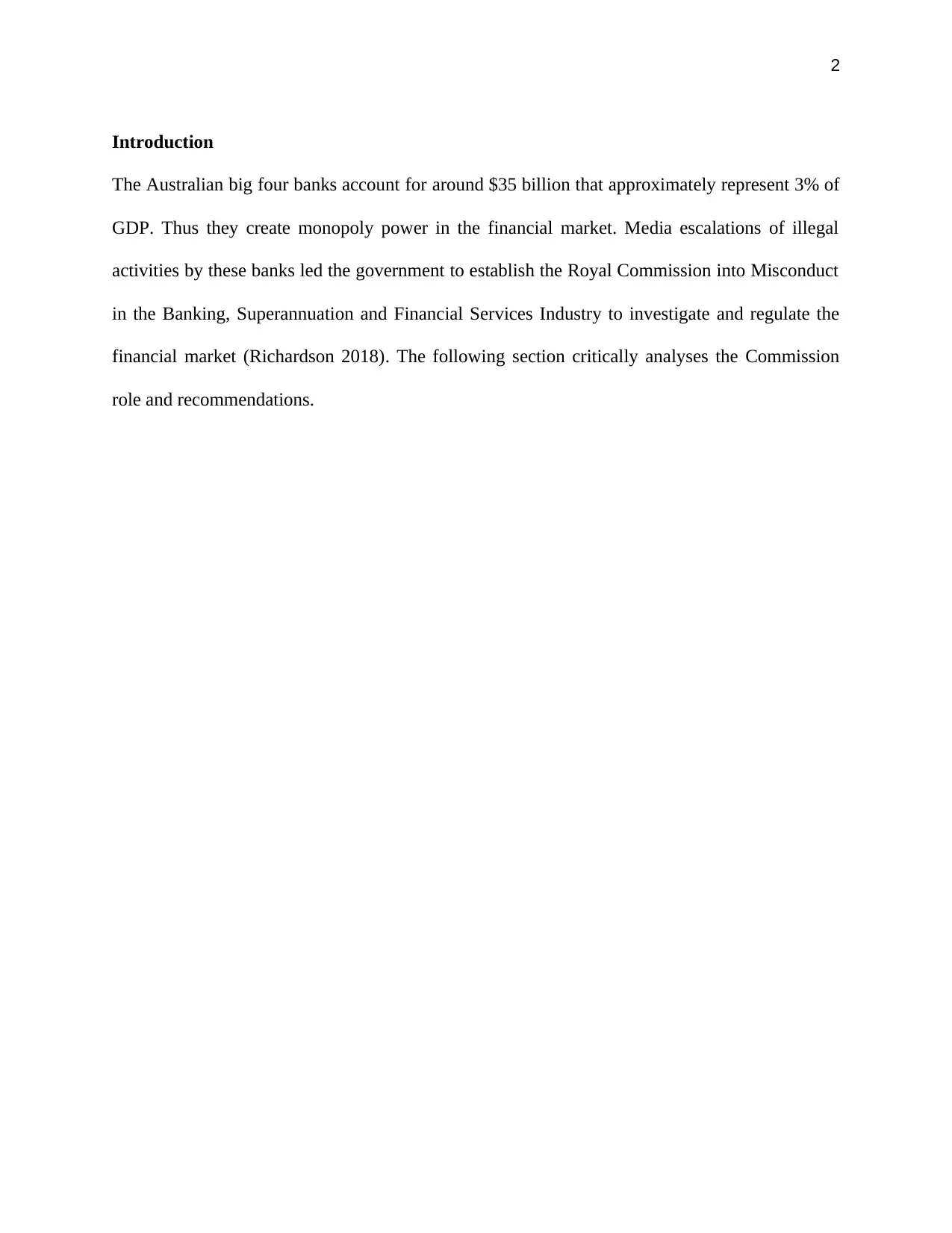
2
Introduction
The Australian big four banks account for around $35 billion that approximately represent 3% of
GDP. Thus they create monopoly power in the financial market. Media escalations of illegal
activities by these banks led the government to establish the Royal Commission into Misconduct
in the Banking, Superannuation and Financial Services Industry to investigate and regulate the
financial market (Richardson 2018). The following section critically analyses the Commission
role and recommendations.
Introduction
The Australian big four banks account for around $35 billion that approximately represent 3% of
GDP. Thus they create monopoly power in the financial market. Media escalations of illegal
activities by these banks led the government to establish the Royal Commission into Misconduct
in the Banking, Superannuation and Financial Services Industry to investigate and regulate the
financial market (Richardson 2018). The following section critically analyses the Commission
role and recommendations.
⊘ This is a preview!⊘
Do you want full access?
Subscribe today to unlock all pages.

Trusted by 1+ million students worldwide
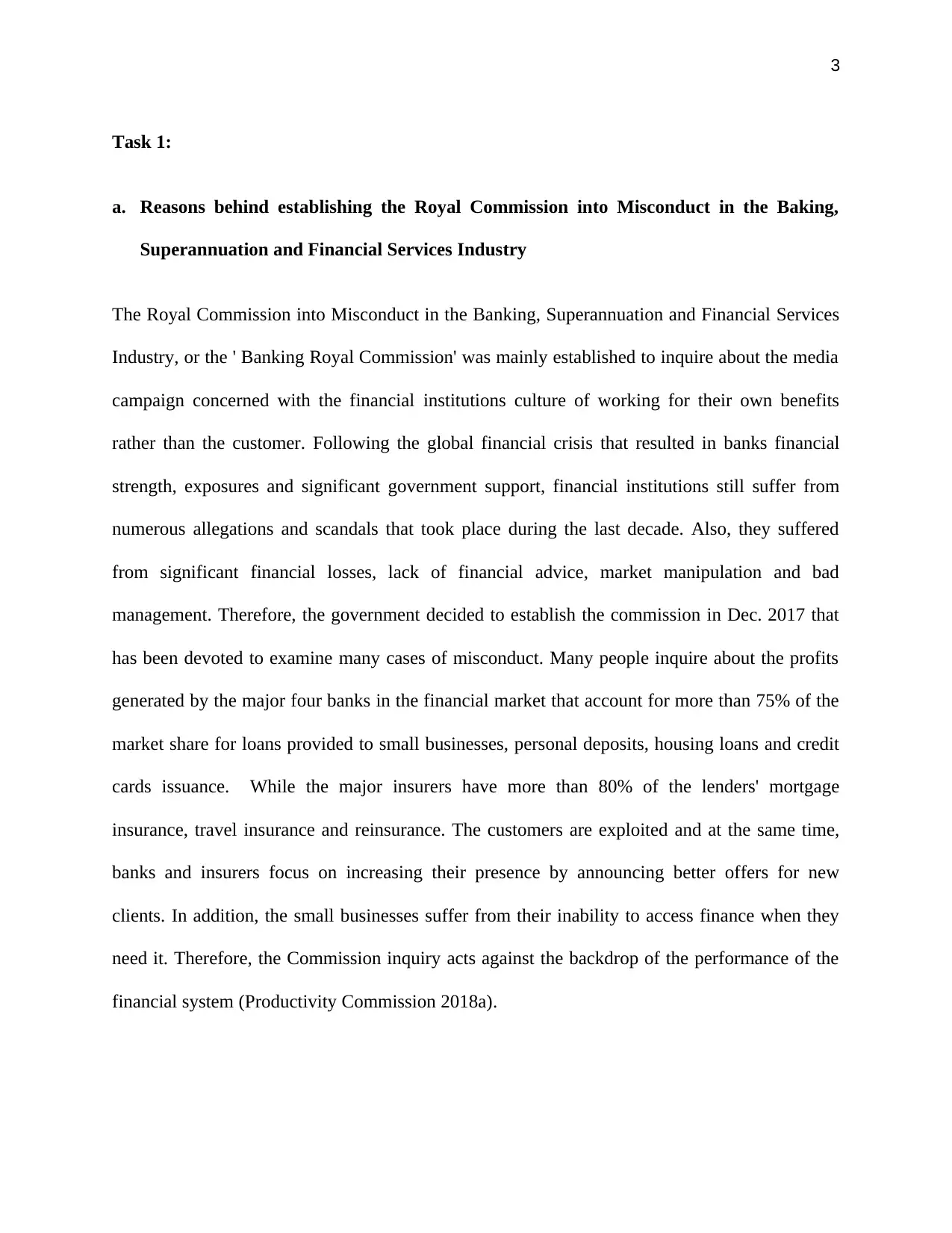
3
Task 1:
a. Reasons behind establishing the Royal Commission into Misconduct in the Baking,
Superannuation and Financial Services Industry
The Royal Commission into Misconduct in the Banking, Superannuation and Financial Services
Industry, or the ' Banking Royal Commission' was mainly established to inquire about the media
campaign concerned with the financial institutions culture of working for their own benefits
rather than the customer. Following the global financial crisis that resulted in banks financial
strength, exposures and significant government support, financial institutions still suffer from
numerous allegations and scandals that took place during the last decade. Also, they suffered
from significant financial losses, lack of financial advice, market manipulation and bad
management. Therefore, the government decided to establish the commission in Dec. 2017 that
has been devoted to examine many cases of misconduct. Many people inquire about the profits
generated by the major four banks in the financial market that account for more than 75% of the
market share for loans provided to small businesses, personal deposits, housing loans and credit
cards issuance. While the major insurers have more than 80% of the lenders' mortgage
insurance, travel insurance and reinsurance. The customers are exploited and at the same time,
banks and insurers focus on increasing their presence by announcing better offers for new
clients. In addition, the small businesses suffer from their inability to access finance when they
need it. Therefore, the Commission inquiry acts against the backdrop of the performance of the
financial system (Productivity Commission 2018a).
Task 1:
a. Reasons behind establishing the Royal Commission into Misconduct in the Baking,
Superannuation and Financial Services Industry
The Royal Commission into Misconduct in the Banking, Superannuation and Financial Services
Industry, or the ' Banking Royal Commission' was mainly established to inquire about the media
campaign concerned with the financial institutions culture of working for their own benefits
rather than the customer. Following the global financial crisis that resulted in banks financial
strength, exposures and significant government support, financial institutions still suffer from
numerous allegations and scandals that took place during the last decade. Also, they suffered
from significant financial losses, lack of financial advice, market manipulation and bad
management. Therefore, the government decided to establish the commission in Dec. 2017 that
has been devoted to examine many cases of misconduct. Many people inquire about the profits
generated by the major four banks in the financial market that account for more than 75% of the
market share for loans provided to small businesses, personal deposits, housing loans and credit
cards issuance. While the major insurers have more than 80% of the lenders' mortgage
insurance, travel insurance and reinsurance. The customers are exploited and at the same time,
banks and insurers focus on increasing their presence by announcing better offers for new
clients. In addition, the small businesses suffer from their inability to access finance when they
need it. Therefore, the Commission inquiry acts against the backdrop of the performance of the
financial system (Productivity Commission 2018a).
Paraphrase This Document
Need a fresh take? Get an instant paraphrase of this document with our AI Paraphraser
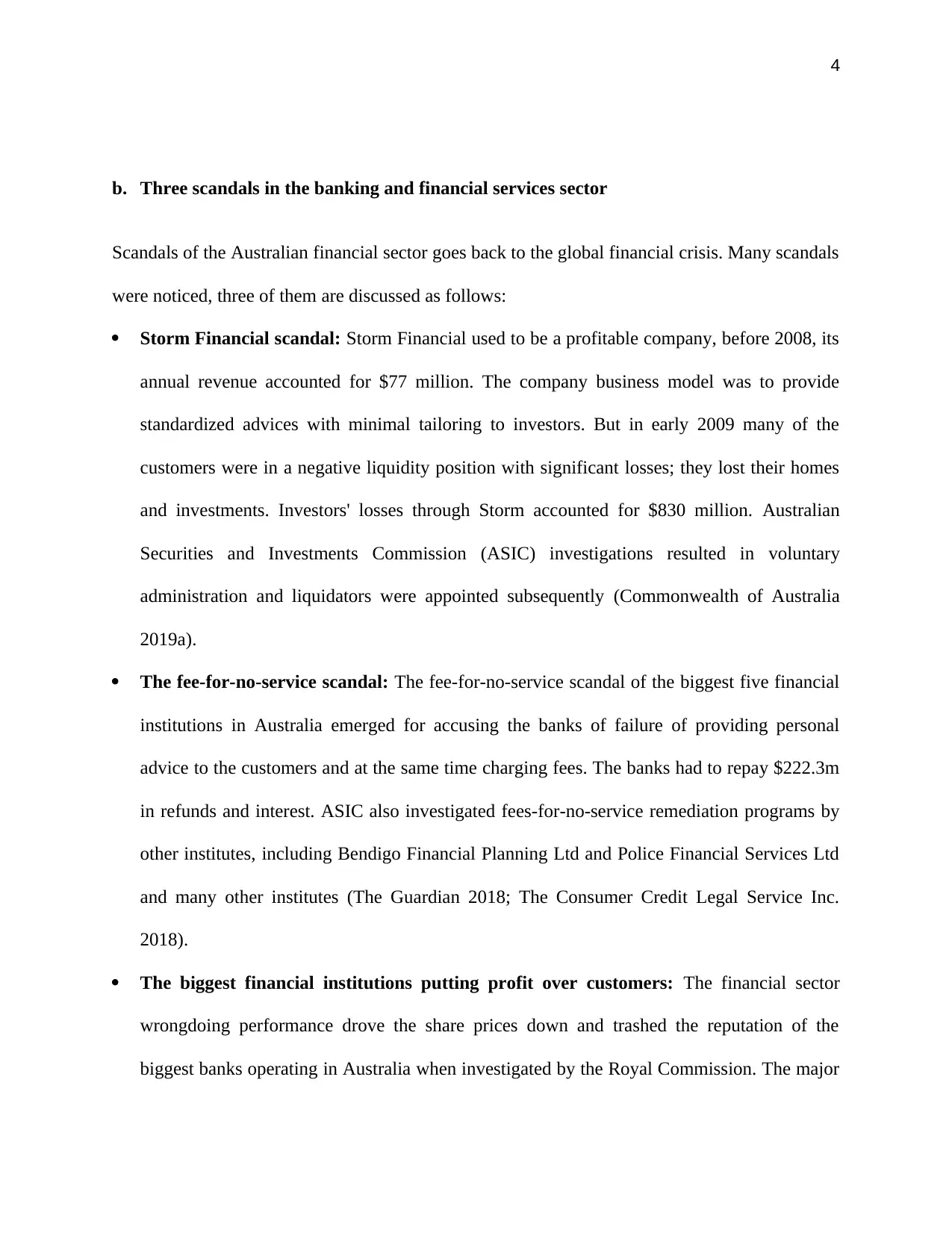
4
b. Three scandals in the banking and financial services sector
Scandals of the Australian financial sector goes back to the global financial crisis. Many scandals
were noticed, three of them are discussed as follows:
Storm Financial scandal: Storm Financial used to be a profitable company, before 2008, its
annual revenue accounted for $77 million. The company business model was to provide
standardized advices with minimal tailoring to investors. But in early 2009 many of the
customers were in a negative liquidity position with significant losses; they lost their homes
and investments. Investors' losses through Storm accounted for $830 million. Australian
Securities and Investments Commission (ASIC) investigations resulted in voluntary
administration and liquidators were appointed subsequently (Commonwealth of Australia
2019a).
The fee-for-no-service scandal: The fee-for-no-service scandal of the biggest five financial
institutions in Australia emerged for accusing the banks of failure of providing personal
advice to the customers and at the same time charging fees. The banks had to repay $222.3m
in refunds and interest. ASIC also investigated fees-for-no-service remediation programs by
other institutes, including Bendigo Financial Planning Ltd and Police Financial Services Ltd
and many other institutes (The Guardian 2018; The Consumer Credit Legal Service Inc.
2018).
The biggest financial institutions putting profit over customers: The financial sector
wrongdoing performance drove the share prices down and trashed the reputation of the
biggest banks operating in Australia when investigated by the Royal Commission. The major
b. Three scandals in the banking and financial services sector
Scandals of the Australian financial sector goes back to the global financial crisis. Many scandals
were noticed, three of them are discussed as follows:
Storm Financial scandal: Storm Financial used to be a profitable company, before 2008, its
annual revenue accounted for $77 million. The company business model was to provide
standardized advices with minimal tailoring to investors. But in early 2009 many of the
customers were in a negative liquidity position with significant losses; they lost their homes
and investments. Investors' losses through Storm accounted for $830 million. Australian
Securities and Investments Commission (ASIC) investigations resulted in voluntary
administration and liquidators were appointed subsequently (Commonwealth of Australia
2019a).
The fee-for-no-service scandal: The fee-for-no-service scandal of the biggest five financial
institutions in Australia emerged for accusing the banks of failure of providing personal
advice to the customers and at the same time charging fees. The banks had to repay $222.3m
in refunds and interest. ASIC also investigated fees-for-no-service remediation programs by
other institutes, including Bendigo Financial Planning Ltd and Police Financial Services Ltd
and many other institutes (The Guardian 2018; The Consumer Credit Legal Service Inc.
2018).
The biggest financial institutions putting profit over customers: The financial sector
wrongdoing performance drove the share prices down and trashed the reputation of the
biggest banks operating in Australia when investigated by the Royal Commission. The major
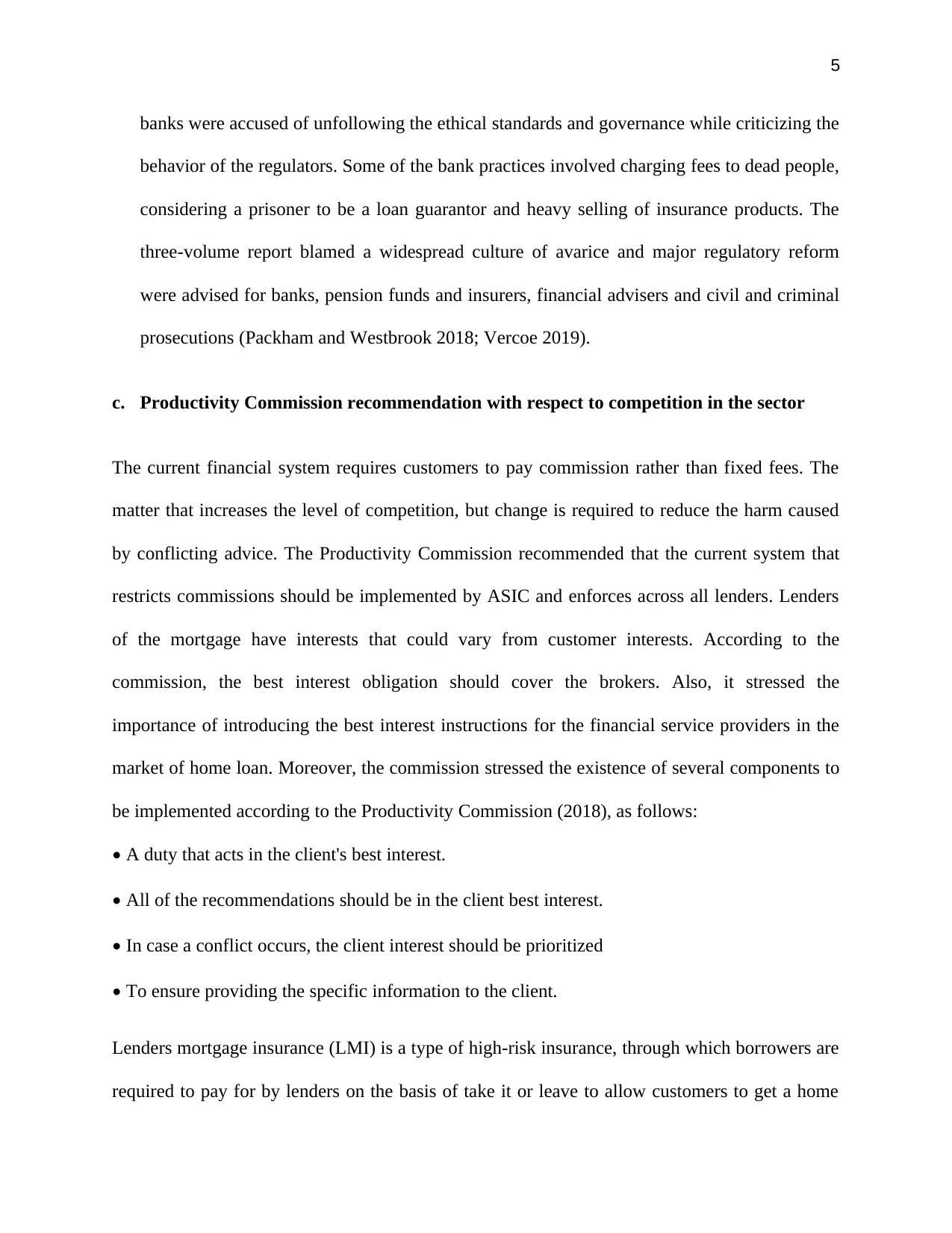
5
banks were accused of unfollowing the ethical standards and governance while criticizing the
behavior of the regulators. Some of the bank practices involved charging fees to dead people,
considering a prisoner to be a loan guarantor and heavy selling of insurance products. The
three-volume report blamed a widespread culture of avarice and major regulatory reform
were advised for banks, pension funds and insurers, financial advisers and civil and criminal
prosecutions (Packham and Westbrook 2018; Vercoe 2019).
c. Productivity Commission recommendation with respect to competition in the sector
The current financial system requires customers to pay commission rather than fixed fees. The
matter that increases the level of competition, but change is required to reduce the harm caused
by conflicting advice. The Productivity Commission recommended that the current system that
restricts commissions should be implemented by ASIC and enforces across all lenders. Lenders
of the mortgage have interests that could vary from customer interests. According to the
commission, the best interest obligation should cover the brokers. Also, it stressed the
importance of introducing the best interest instructions for the financial service providers in the
market of home loan. Moreover, the commission stressed the existence of several components to
be implemented according to the Productivity Commission (2018), as follows:
• A duty that acts in the client's best interest.
• All of the recommendations should be in the client best interest.
• In case a conflict occurs, the client interest should be prioritized
• To ensure providing the specific information to the client.
Lenders mortgage insurance (LMI) is a type of high-risk insurance, through which borrowers are
required to pay for by lenders on the basis of take it or leave to allow customers to get a home
banks were accused of unfollowing the ethical standards and governance while criticizing the
behavior of the regulators. Some of the bank practices involved charging fees to dead people,
considering a prisoner to be a loan guarantor and heavy selling of insurance products. The
three-volume report blamed a widespread culture of avarice and major regulatory reform
were advised for banks, pension funds and insurers, financial advisers and civil and criminal
prosecutions (Packham and Westbrook 2018; Vercoe 2019).
c. Productivity Commission recommendation with respect to competition in the sector
The current financial system requires customers to pay commission rather than fixed fees. The
matter that increases the level of competition, but change is required to reduce the harm caused
by conflicting advice. The Productivity Commission recommended that the current system that
restricts commissions should be implemented by ASIC and enforces across all lenders. Lenders
of the mortgage have interests that could vary from customer interests. According to the
commission, the best interest obligation should cover the brokers. Also, it stressed the
importance of introducing the best interest instructions for the financial service providers in the
market of home loan. Moreover, the commission stressed the existence of several components to
be implemented according to the Productivity Commission (2018), as follows:
• A duty that acts in the client's best interest.
• All of the recommendations should be in the client best interest.
• In case a conflict occurs, the client interest should be prioritized
• To ensure providing the specific information to the client.
Lenders mortgage insurance (LMI) is a type of high-risk insurance, through which borrowers are
required to pay for by lenders on the basis of take it or leave to allow customers to get a home
⊘ This is a preview!⊘
Do you want full access?
Subscribe today to unlock all pages.

Trusted by 1+ million students worldwide
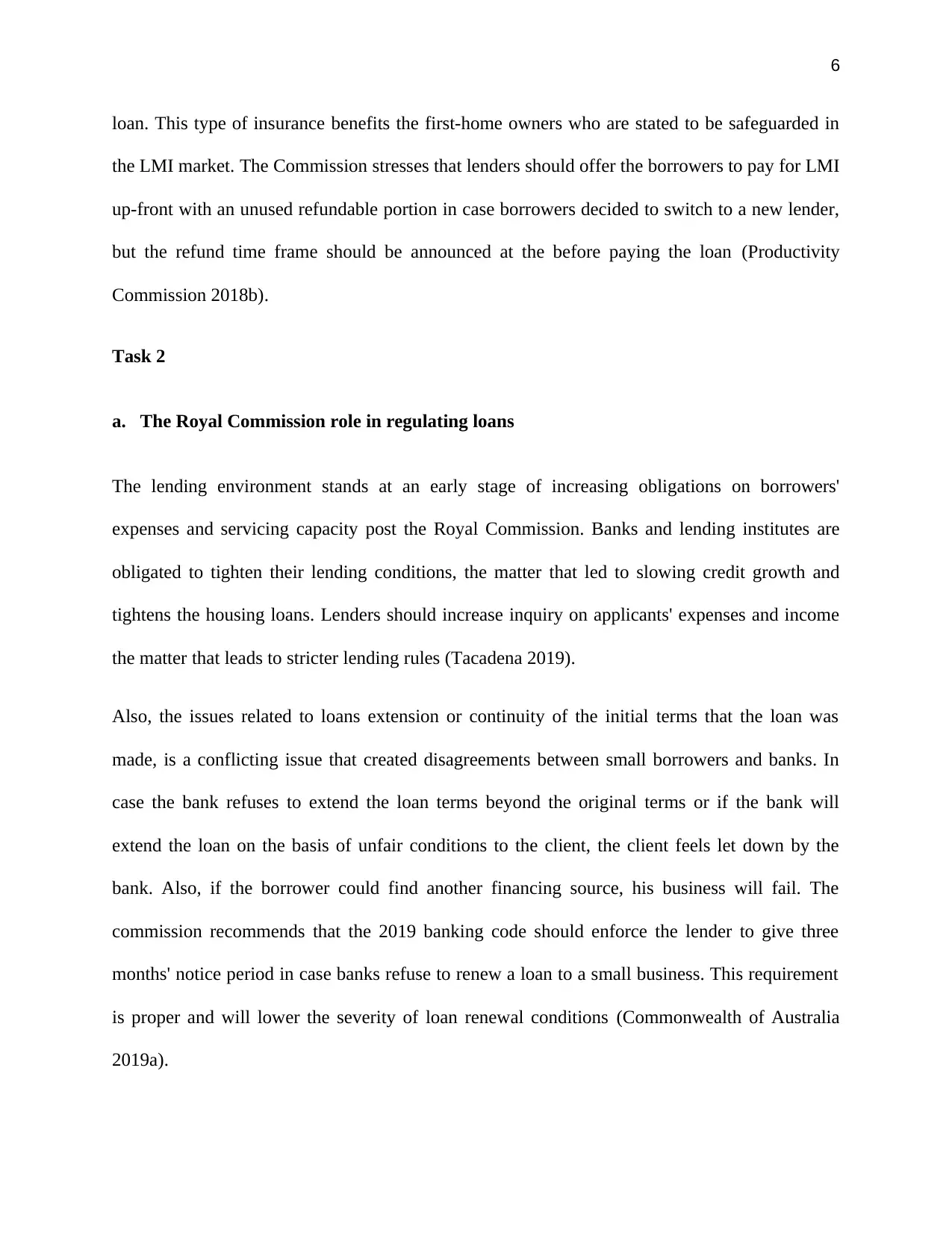
6
loan. This type of insurance benefits the first-home owners who are stated to be safeguarded in
the LMI market. The Commission stresses that lenders should offer the borrowers to pay for LMI
up-front with an unused refundable portion in case borrowers decided to switch to a new lender,
but the refund time frame should be announced at the before paying the loan (Productivity
Commission 2018b).
Task 2
a. The Royal Commission role in regulating loans
The lending environment stands at an early stage of increasing obligations on borrowers'
expenses and servicing capacity post the Royal Commission. Banks and lending institutes are
obligated to tighten their lending conditions, the matter that led to slowing credit growth and
tightens the housing loans. Lenders should increase inquiry on applicants' expenses and income
the matter that leads to stricter lending rules (Tacadena 2019).
Also, the issues related to loans extension or continuity of the initial terms that the loan was
made, is a conflicting issue that created disagreements between small borrowers and banks. In
case the bank refuses to extend the loan terms beyond the original terms or if the bank will
extend the loan on the basis of unfair conditions to the client, the client feels let down by the
bank. Also, if the borrower could find another financing source, his business will fail. The
commission recommends that the 2019 banking code should enforce the lender to give three
months' notice period in case banks refuse to renew a loan to a small business. This requirement
is proper and will lower the severity of loan renewal conditions (Commonwealth of Australia
2019a).
loan. This type of insurance benefits the first-home owners who are stated to be safeguarded in
the LMI market. The Commission stresses that lenders should offer the borrowers to pay for LMI
up-front with an unused refundable portion in case borrowers decided to switch to a new lender,
but the refund time frame should be announced at the before paying the loan (Productivity
Commission 2018b).
Task 2
a. The Royal Commission role in regulating loans
The lending environment stands at an early stage of increasing obligations on borrowers'
expenses and servicing capacity post the Royal Commission. Banks and lending institutes are
obligated to tighten their lending conditions, the matter that led to slowing credit growth and
tightens the housing loans. Lenders should increase inquiry on applicants' expenses and income
the matter that leads to stricter lending rules (Tacadena 2019).
Also, the issues related to loans extension or continuity of the initial terms that the loan was
made, is a conflicting issue that created disagreements between small borrowers and banks. In
case the bank refuses to extend the loan terms beyond the original terms or if the bank will
extend the loan on the basis of unfair conditions to the client, the client feels let down by the
bank. Also, if the borrower could find another financing source, his business will fail. The
commission recommends that the 2019 banking code should enforce the lender to give three
months' notice period in case banks refuse to renew a loan to a small business. This requirement
is proper and will lower the severity of loan renewal conditions (Commonwealth of Australia
2019a).
Paraphrase This Document
Need a fresh take? Get an instant paraphrase of this document with our AI Paraphraser
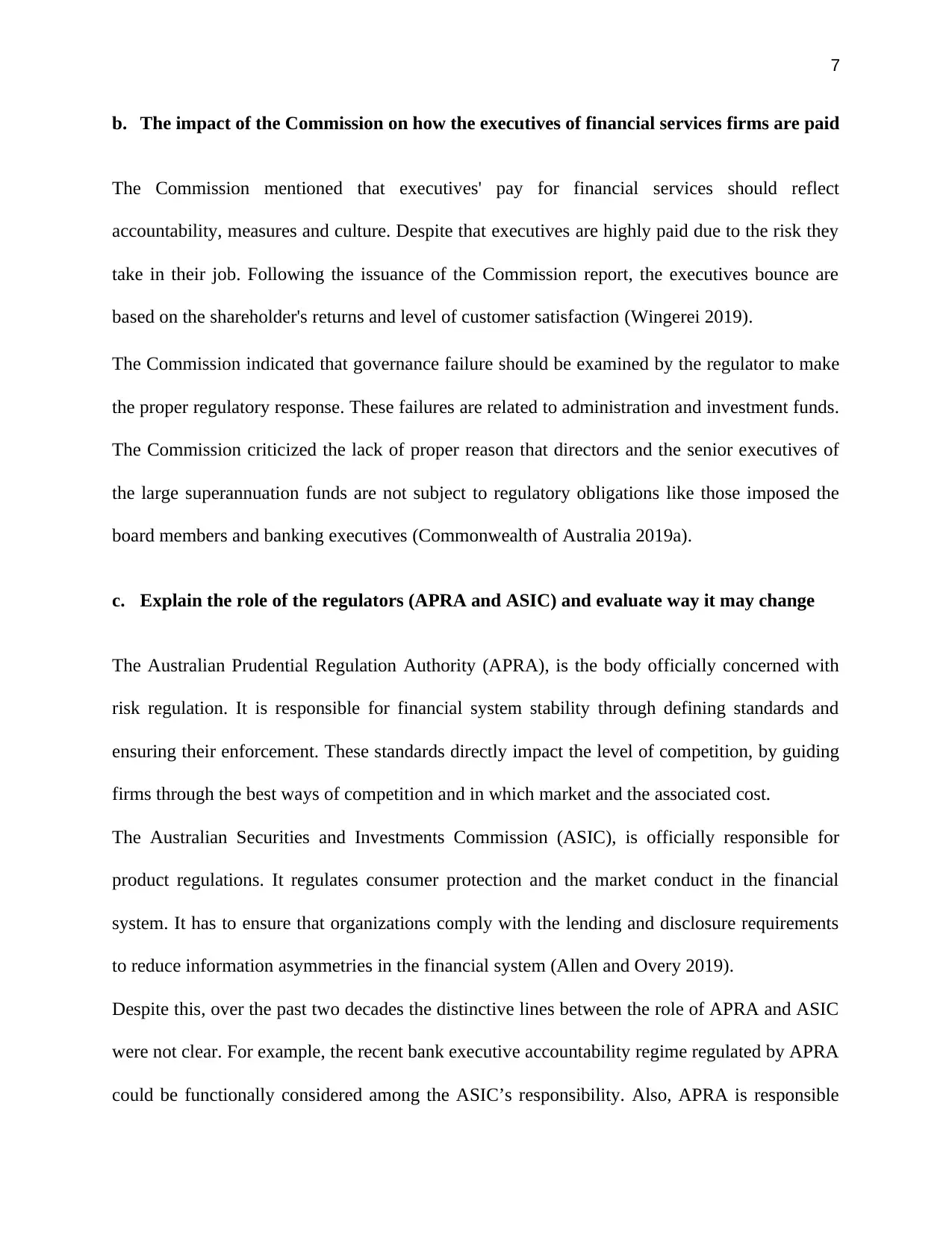
7
b. The impact of the Commission on how the executives of financial services firms are paid
The Commission mentioned that executives' pay for financial services should reflect
accountability, measures and culture. Despite that executives are highly paid due to the risk they
take in their job. Following the issuance of the Commission report, the executives bounce are
based on the shareholder's returns and level of customer satisfaction (Wingerei 2019).
The Commission indicated that governance failure should be examined by the regulator to make
the proper regulatory response. These failures are related to administration and investment funds.
The Commission criticized the lack of proper reason that directors and the senior executives of
the large superannuation funds are not subject to regulatory obligations like those imposed the
board members and banking executives (Commonwealth of Australia 2019a).
c. Explain the role of the regulators (APRA and ASIC) and evaluate way it may change
The Australian Prudential Regulation Authority (APRA), is the body officially concerned with
risk regulation. It is responsible for financial system stability through defining standards and
ensuring their enforcement. These standards directly impact the level of competition, by guiding
firms through the best ways of competition and in which market and the associated cost.
The Australian Securities and Investments Commission (ASIC), is officially responsible for
product regulations. It regulates consumer protection and the market conduct in the financial
system. It has to ensure that organizations comply with the lending and disclosure requirements
to reduce information asymmetries in the financial system (Allen and Overy 2019).
Despite this, over the past two decades the distinctive lines between the role of APRA and ASIC
were not clear. For example, the recent bank executive accountability regime regulated by APRA
could be functionally considered among the ASIC’s responsibility. Also, APRA is responsible
b. The impact of the Commission on how the executives of financial services firms are paid
The Commission mentioned that executives' pay for financial services should reflect
accountability, measures and culture. Despite that executives are highly paid due to the risk they
take in their job. Following the issuance of the Commission report, the executives bounce are
based on the shareholder's returns and level of customer satisfaction (Wingerei 2019).
The Commission indicated that governance failure should be examined by the regulator to make
the proper regulatory response. These failures are related to administration and investment funds.
The Commission criticized the lack of proper reason that directors and the senior executives of
the large superannuation funds are not subject to regulatory obligations like those imposed the
board members and banking executives (Commonwealth of Australia 2019a).
c. Explain the role of the regulators (APRA and ASIC) and evaluate way it may change
The Australian Prudential Regulation Authority (APRA), is the body officially concerned with
risk regulation. It is responsible for financial system stability through defining standards and
ensuring their enforcement. These standards directly impact the level of competition, by guiding
firms through the best ways of competition and in which market and the associated cost.
The Australian Securities and Investments Commission (ASIC), is officially responsible for
product regulations. It regulates consumer protection and the market conduct in the financial
system. It has to ensure that organizations comply with the lending and disclosure requirements
to reduce information asymmetries in the financial system (Allen and Overy 2019).
Despite this, over the past two decades the distinctive lines between the role of APRA and ASIC
were not clear. For example, the recent bank executive accountability regime regulated by APRA
could be functionally considered among the ASIC’s responsibility. Also, APRA is responsible
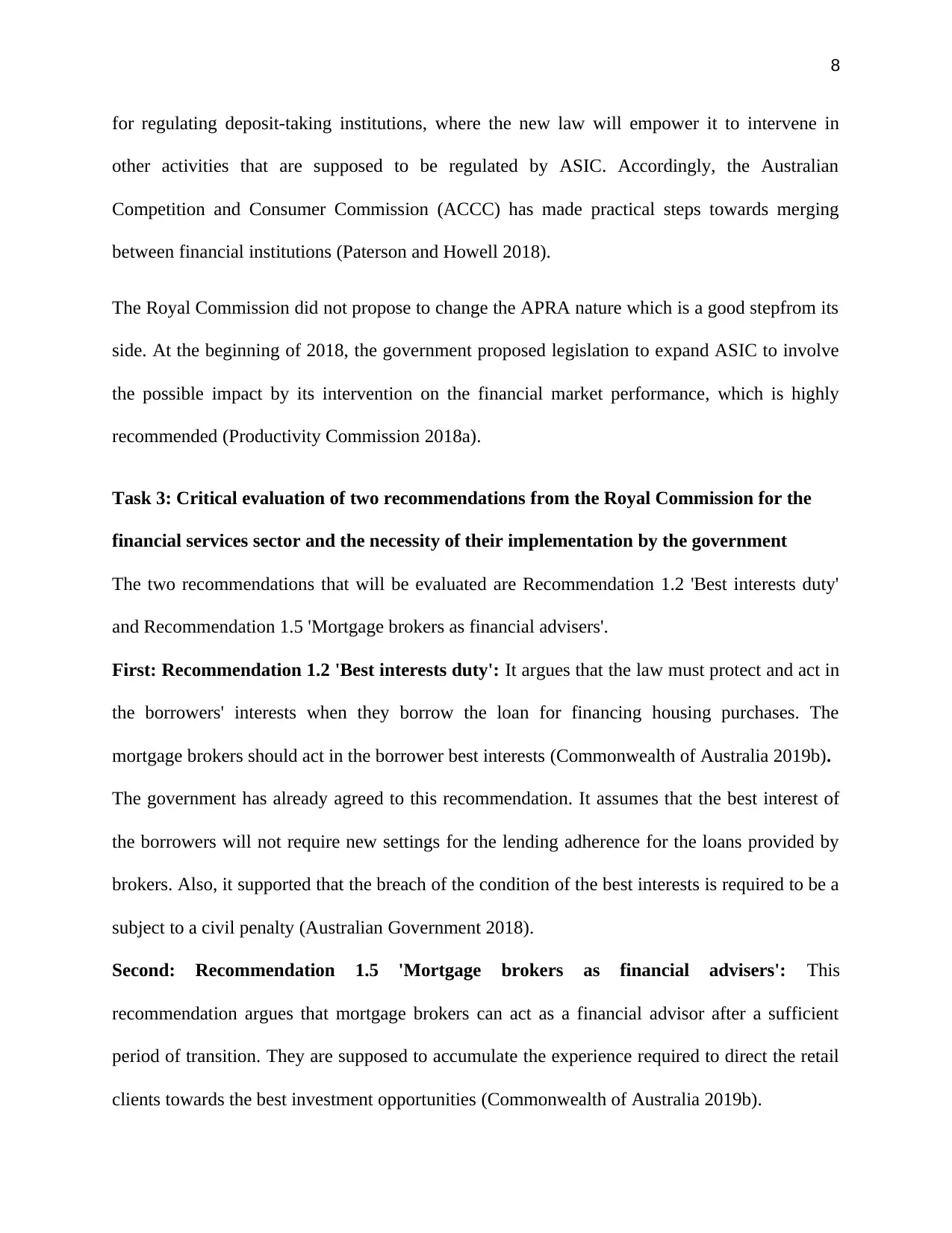
8
for regulating deposit-taking institutions, where the new law will empower it to intervene in
other activities that are supposed to be regulated by ASIC. Accordingly, the Australian
Competition and Consumer Commission (ACCC) has made practical steps towards merging
between financial institutions (Paterson and Howell 2018).
The Royal Commission did not propose to change the APRA nature which is a good stepfrom its
side. At the beginning of 2018, the government proposed legislation to expand ASIC to involve
the possible impact by its intervention on the financial market performance, which is highly
recommended (Productivity Commission 2018a).
Task 3: Critical evaluation of two recommendations from the Royal Commission for the
financial services sector and the necessity of their implementation by the government
The two recommendations that will be evaluated are Recommendation 1.2 'Best interests duty'
and Recommendation 1.5 'Mortgage brokers as financial advisers'.
First: Recommendation 1.2 'Best interests duty': It argues that the law must protect and act in
the borrowers' interests when they borrow the loan for financing housing purchases. The
mortgage brokers should act in the borrower best interests (Commonwealth of Australia 2019b).
The government has already agreed to this recommendation. It assumes that the best interest of
the borrowers will not require new settings for the lending adherence for the loans provided by
brokers. Also, it supported that the breach of the condition of the best interests is required to be a
subject to a civil penalty (Australian Government 2018).
Second: Recommendation 1.5 'Mortgage brokers as financial advisers': This
recommendation argues that mortgage brokers can act as a financial advisor after a sufficient
period of transition. They are supposed to accumulate the experience required to direct the retail
clients towards the best investment opportunities (Commonwealth of Australia 2019b).
for regulating deposit-taking institutions, where the new law will empower it to intervene in
other activities that are supposed to be regulated by ASIC. Accordingly, the Australian
Competition and Consumer Commission (ACCC) has made practical steps towards merging
between financial institutions (Paterson and Howell 2018).
The Royal Commission did not propose to change the APRA nature which is a good stepfrom its
side. At the beginning of 2018, the government proposed legislation to expand ASIC to involve
the possible impact by its intervention on the financial market performance, which is highly
recommended (Productivity Commission 2018a).
Task 3: Critical evaluation of two recommendations from the Royal Commission for the
financial services sector and the necessity of their implementation by the government
The two recommendations that will be evaluated are Recommendation 1.2 'Best interests duty'
and Recommendation 1.5 'Mortgage brokers as financial advisers'.
First: Recommendation 1.2 'Best interests duty': It argues that the law must protect and act in
the borrowers' interests when they borrow the loan for financing housing purchases. The
mortgage brokers should act in the borrower best interests (Commonwealth of Australia 2019b).
The government has already agreed to this recommendation. It assumes that the best interest of
the borrowers will not require new settings for the lending adherence for the loans provided by
brokers. Also, it supported that the breach of the condition of the best interests is required to be a
subject to a civil penalty (Australian Government 2018).
Second: Recommendation 1.5 'Mortgage brokers as financial advisers': This
recommendation argues that mortgage brokers can act as a financial advisor after a sufficient
period of transition. They are supposed to accumulate the experience required to direct the retail
clients towards the best investment opportunities (Commonwealth of Australia 2019b).
⊘ This is a preview!⊘
Do you want full access?
Subscribe today to unlock all pages.

Trusted by 1+ million students worldwide
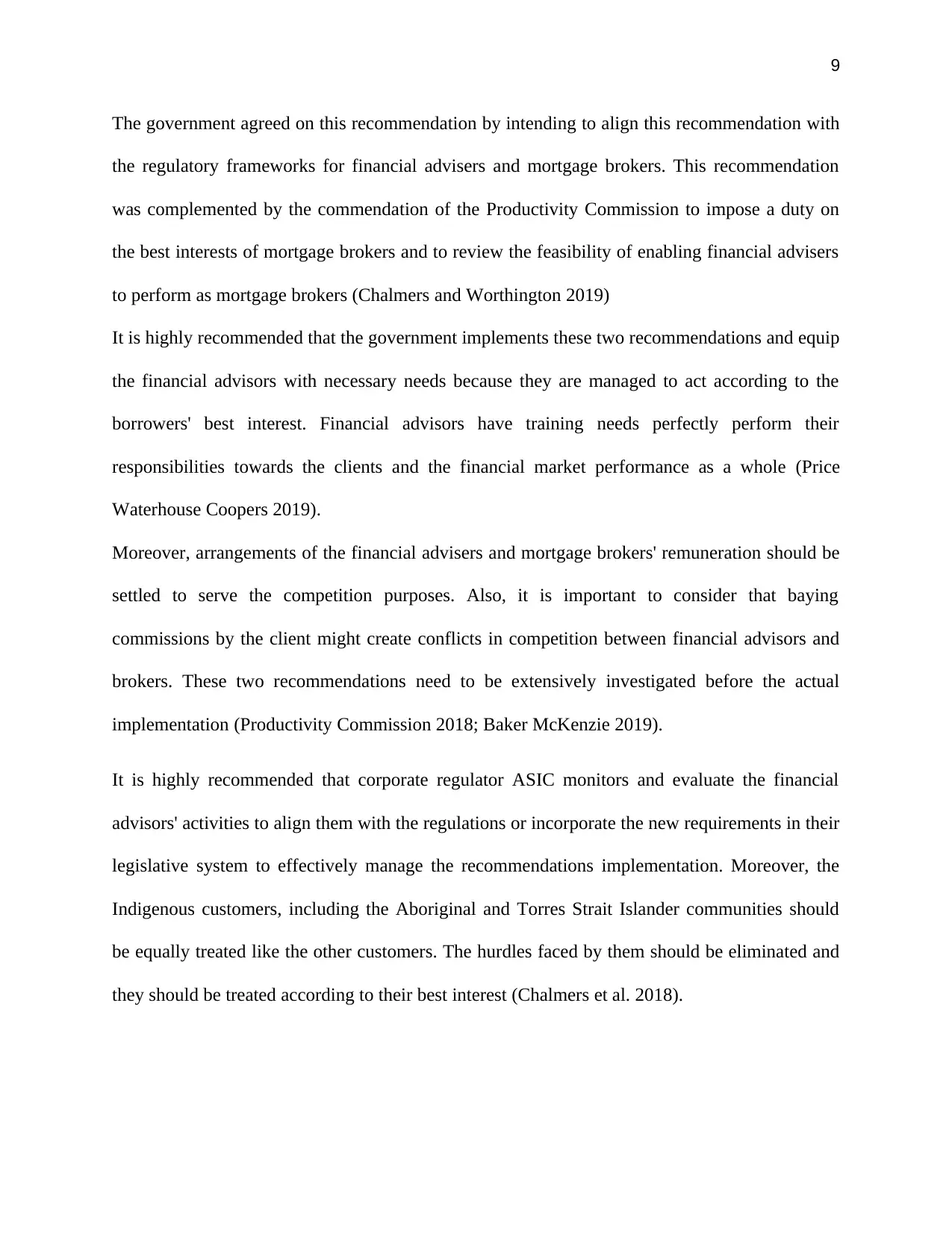
9
The government agreed on this recommendation by intending to align this recommendation with
the regulatory frameworks for financial advisers and mortgage brokers. This recommendation
was complemented by the commendation of the Productivity Commission to impose a duty on
the best interests of mortgage brokers and to review the feasibility of enabling financial advisers
to perform as mortgage brokers (Chalmers and Worthington 2019)
It is highly recommended that the government implements these two recommendations and equip
the financial advisors with necessary needs because they are managed to act according to the
borrowers' best interest. Financial advisors have training needs perfectly perform their
responsibilities towards the clients and the financial market performance as a whole (Price
Waterhouse Coopers 2019).
Moreover, arrangements of the financial advisers and mortgage brokers' remuneration should be
settled to serve the competition purposes. Also, it is important to consider that baying
commissions by the client might create conflicts in competition between financial advisors and
brokers. These two recommendations need to be extensively investigated before the actual
implementation (Productivity Commission 2018; Baker McKenzie 2019).
It is highly recommended that corporate regulator ASIC monitors and evaluate the financial
advisors' activities to align them with the regulations or incorporate the new requirements in their
legislative system to effectively manage the recommendations implementation. Moreover, the
Indigenous customers, including the Aboriginal and Torres Strait Islander communities should
be equally treated like the other customers. The hurdles faced by them should be eliminated and
they should be treated according to their best interest (Chalmers et al. 2018).
The government agreed on this recommendation by intending to align this recommendation with
the regulatory frameworks for financial advisers and mortgage brokers. This recommendation
was complemented by the commendation of the Productivity Commission to impose a duty on
the best interests of mortgage brokers and to review the feasibility of enabling financial advisers
to perform as mortgage brokers (Chalmers and Worthington 2019)
It is highly recommended that the government implements these two recommendations and equip
the financial advisors with necessary needs because they are managed to act according to the
borrowers' best interest. Financial advisors have training needs perfectly perform their
responsibilities towards the clients and the financial market performance as a whole (Price
Waterhouse Coopers 2019).
Moreover, arrangements of the financial advisers and mortgage brokers' remuneration should be
settled to serve the competition purposes. Also, it is important to consider that baying
commissions by the client might create conflicts in competition between financial advisors and
brokers. These two recommendations need to be extensively investigated before the actual
implementation (Productivity Commission 2018; Baker McKenzie 2019).
It is highly recommended that corporate regulator ASIC monitors and evaluate the financial
advisors' activities to align them with the regulations or incorporate the new requirements in their
legislative system to effectively manage the recommendations implementation. Moreover, the
Indigenous customers, including the Aboriginal and Torres Strait Islander communities should
be equally treated like the other customers. The hurdles faced by them should be eliminated and
they should be treated according to their best interest (Chalmers et al. 2018).
Paraphrase This Document
Need a fresh take? Get an instant paraphrase of this document with our AI Paraphraser
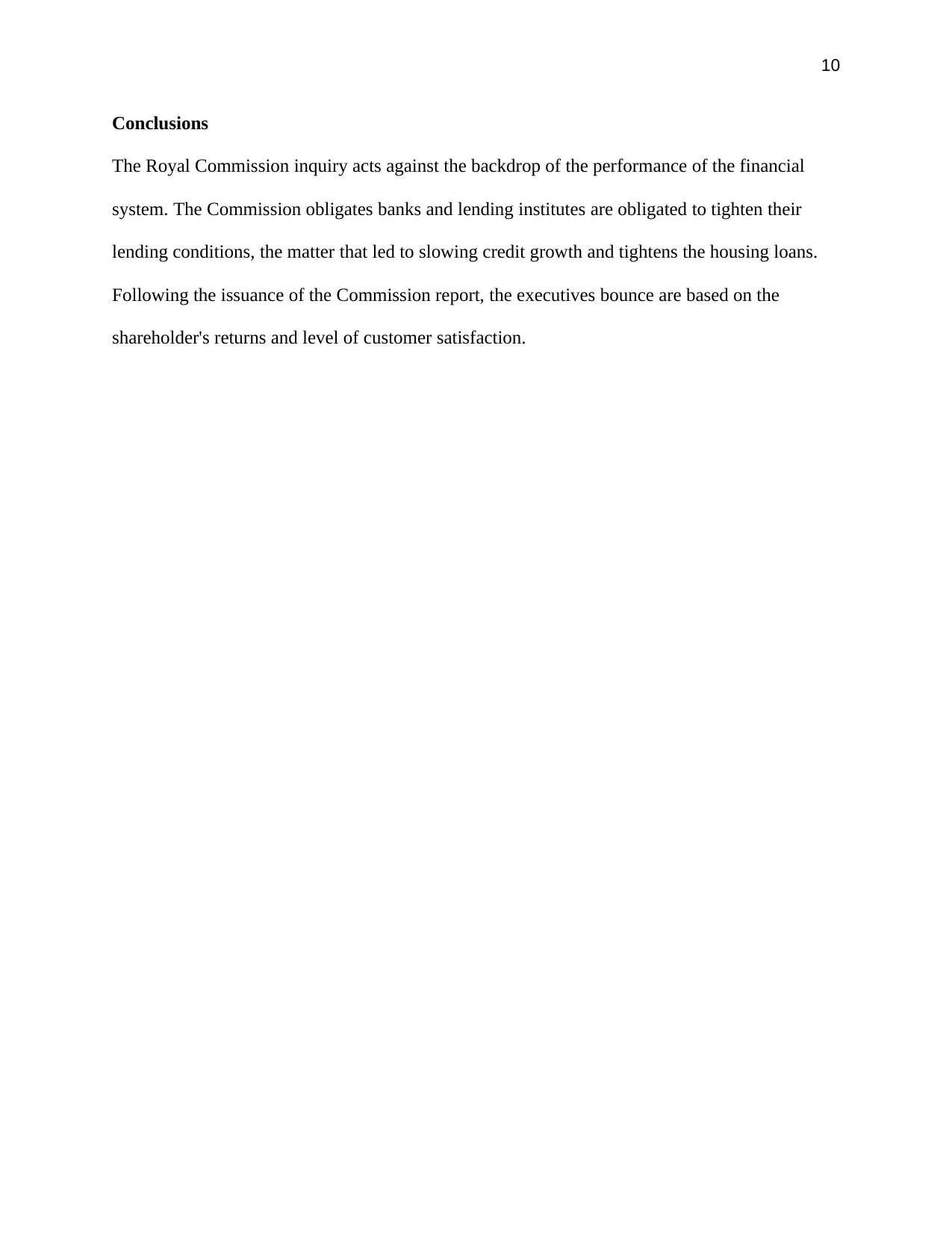
10
Conclusions
The Royal Commission inquiry acts against the backdrop of the performance of the financial
system. The Commission obligates banks and lending institutes are obligated to tighten their
lending conditions, the matter that led to slowing credit growth and tightens the housing loans.
Following the issuance of the Commission report, the executives bounce are based on the
shareholder's returns and level of customer satisfaction.
Conclusions
The Royal Commission inquiry acts against the backdrop of the performance of the financial
system. The Commission obligates banks and lending institutes are obligated to tighten their
lending conditions, the matter that led to slowing credit growth and tightens the housing loans.
Following the issuance of the Commission report, the executives bounce are based on the
shareholder's returns and level of customer satisfaction.
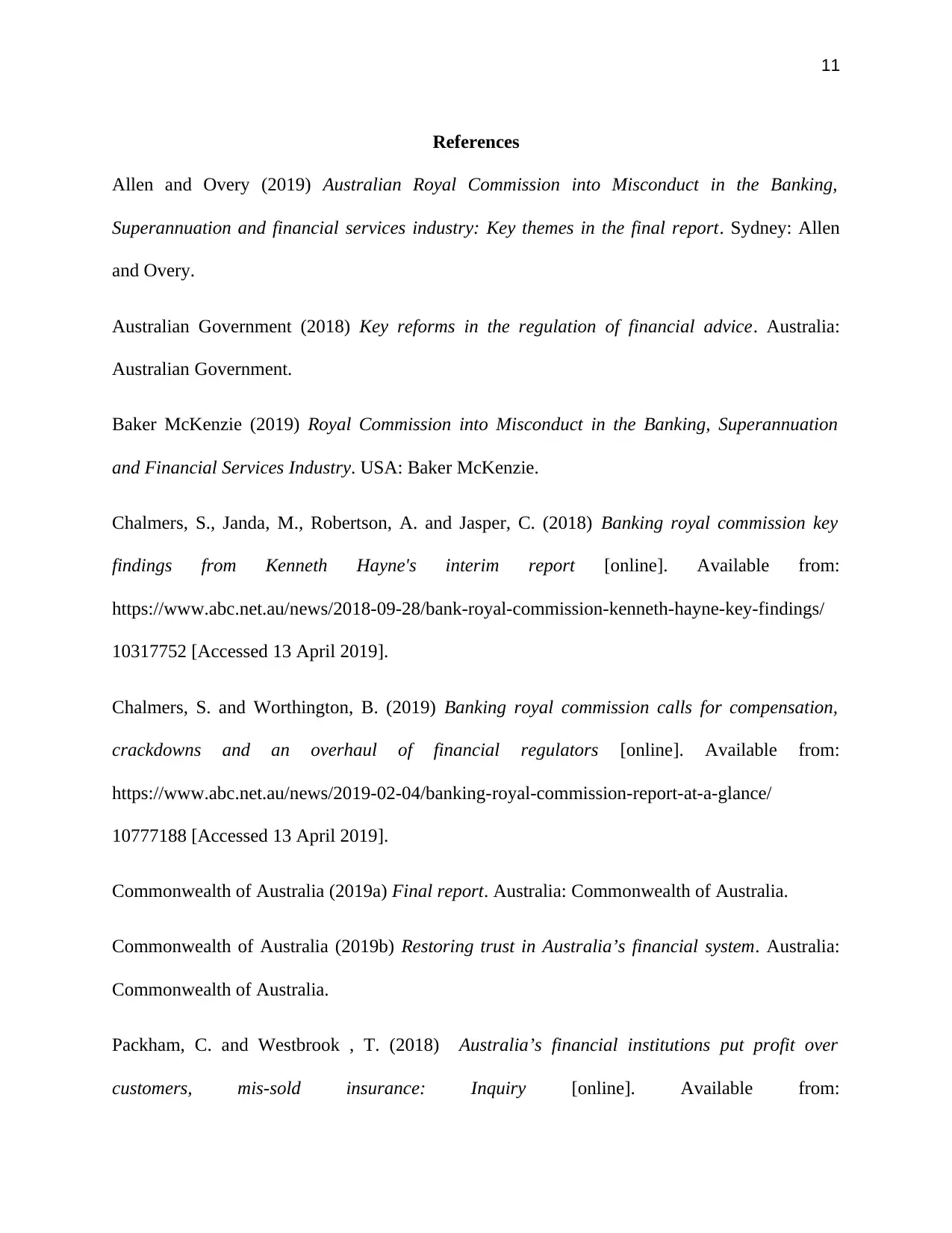
11
References
Allen and Overy (2019) Australian Royal Commission into Misconduct in the Banking,
Superannuation and financial services industry: Key themes in the final report. Sydney: Allen
and Overy.
Australian Government (2018) Key reforms in the regulation of financial advice. Australia:
Australian Government.
Baker McKenzie (2019) Royal Commission into Misconduct in the Banking, Superannuation
and Financial Services Industry. USA: Baker McKenzie.
Chalmers, S., Janda, M., Robertson, A. and Jasper, C. (2018) Banking royal commission key
findings from Kenneth Hayne's interim report [online]. Available from:
https://www.abc.net.au/news/2018-09-28/bank-royal-commission-kenneth-hayne-key-findings/
10317752 [Accessed 13 April 2019].
Chalmers, S. and Worthington, B. (2019) Banking royal commission calls for compensation,
crackdowns and an overhaul of financial regulators [online]. Available from:
https://www.abc.net.au/news/2019-02-04/banking-royal-commission-report-at-a-glance/
10777188 [Accessed 13 April 2019].
Commonwealth of Australia (2019a) Final report. Australia: Commonwealth of Australia.
Commonwealth of Australia (2019b) Restoring trust in Australia’s financial system. Australia:
Commonwealth of Australia.
Packham, C. and Westbrook , T. (2018) Australia’s financial institutions put profit over
customers, mis-sold insurance: Inquiry [online]. Available from:
References
Allen and Overy (2019) Australian Royal Commission into Misconduct in the Banking,
Superannuation and financial services industry: Key themes in the final report. Sydney: Allen
and Overy.
Australian Government (2018) Key reforms in the regulation of financial advice. Australia:
Australian Government.
Baker McKenzie (2019) Royal Commission into Misconduct in the Banking, Superannuation
and Financial Services Industry. USA: Baker McKenzie.
Chalmers, S., Janda, M., Robertson, A. and Jasper, C. (2018) Banking royal commission key
findings from Kenneth Hayne's interim report [online]. Available from:
https://www.abc.net.au/news/2018-09-28/bank-royal-commission-kenneth-hayne-key-findings/
10317752 [Accessed 13 April 2019].
Chalmers, S. and Worthington, B. (2019) Banking royal commission calls for compensation,
crackdowns and an overhaul of financial regulators [online]. Available from:
https://www.abc.net.au/news/2019-02-04/banking-royal-commission-report-at-a-glance/
10777188 [Accessed 13 April 2019].
Commonwealth of Australia (2019a) Final report. Australia: Commonwealth of Australia.
Commonwealth of Australia (2019b) Restoring trust in Australia’s financial system. Australia:
Commonwealth of Australia.
Packham, C. and Westbrook , T. (2018) Australia’s financial institutions put profit over
customers, mis-sold insurance: Inquiry [online]. Available from:
⊘ This is a preview!⊘
Do you want full access?
Subscribe today to unlock all pages.

Trusted by 1+ million students worldwide
1 out of 14
Related Documents
Your All-in-One AI-Powered Toolkit for Academic Success.
+13062052269
info@desklib.com
Available 24*7 on WhatsApp / Email
![[object Object]](/_next/static/media/star-bottom.7253800d.svg)
Unlock your academic potential
Copyright © 2020–2025 A2Z Services. All Rights Reserved. Developed and managed by ZUCOL.





